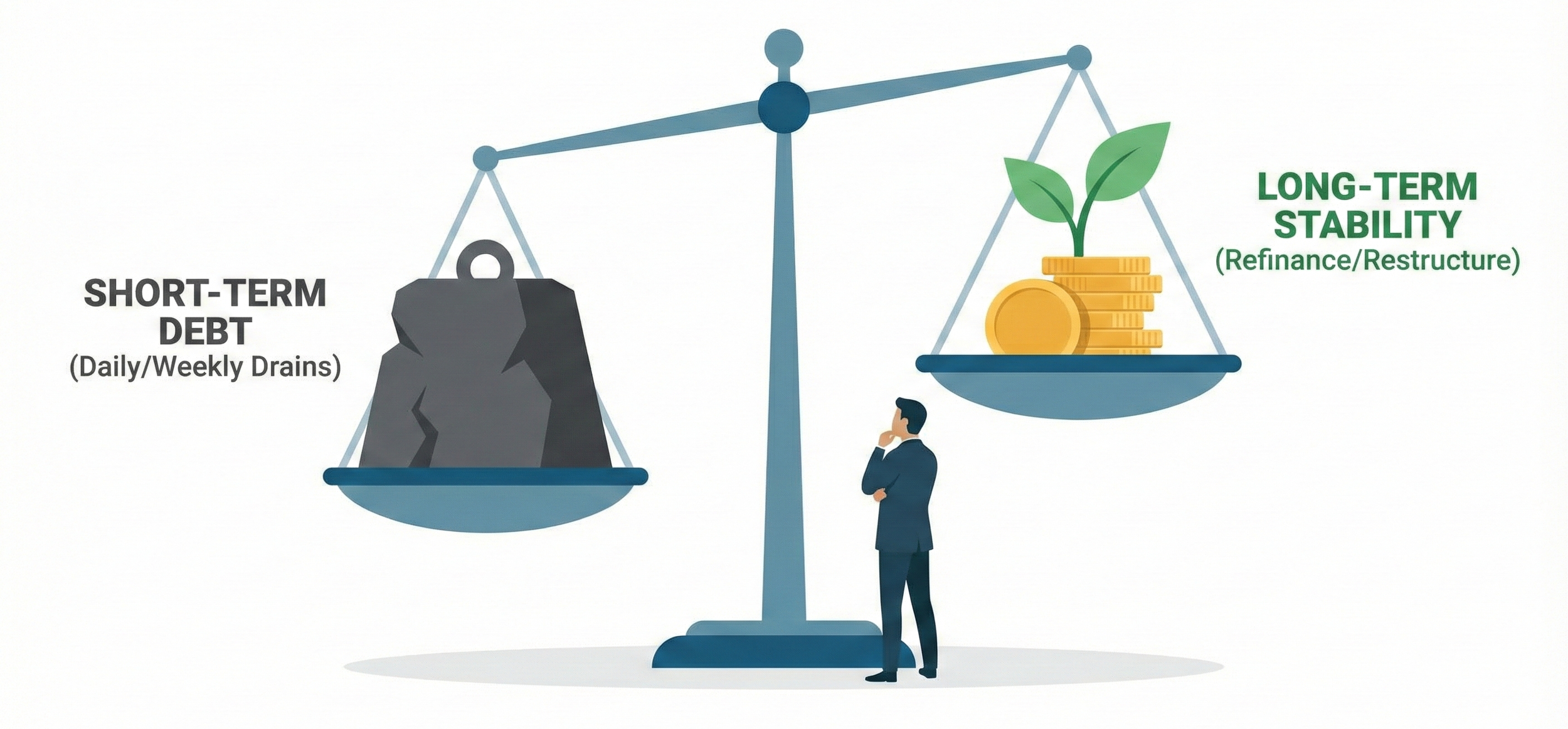General Requirements (takes about 5-minutes or less to apply online)
680+ FICO score (Transunion or Experian FICO model 8.0 or similar)
Less than 15% operating loss in the last year of business
Last 2-Years of filed Business Tax Returns; Last 1-Year of filed Personal Tax Returns
Last 3-months of bank statements; copy of Driver’s License
Correcting Course:
Fixing Business Financial Mistakes
Even the most astute business owners, with the best intentions and meticulous planning, can encounter financial missteps.
The dynamic nature of markets, unexpected economic shifts, internal operational challenges, or simply a misjudgment can lead to financial blunders that threaten stability and growth.
However, recognizing these mistakes is the first step; taking decisive action to correct them is what truly defines a resilient and successful enterprise.
This article explores common business financing mistakes and, more importantly, provides a practical roadmap for identifying, analyzing, and rectifying them.
It's about turning setbacks into opportunities for learning and building a stronger financial foundation for your business.
The Peril of Unmanaged Cash Flow:
From Crisis to Control
Perhaps the most common and immediate financial mistake is poor cash flow management.
Businesses, even profitable ones, can crumble if they run out of liquid funds to cover their short-term obligations.
This often manifests as missed supplier payments, inability to meet payroll, or foregone growth opportunities due to lack of working capital.
How to Fix It:
Implement a Robust Cash Flow Forecasting System: Move beyond guesswork. Use historical data and realistic projections to create weekly or bi-weekly cash flow forecasts. This helps identify potential shortfalls before they become crises.
Accelerate Receivables: Tighten your invoicing process. Send invoices promptly, offer early payment incentives, and establish clear follow-up procedures for overdue accounts. Consider invoice factoring or discounting for immediate cash if appropriate.
Optimize Payables: While you want to pay on time to maintain supplier relationships, strategically manage your payment terms. Negotiate longer payment windows when possible, but avoid delaying payments that incur penalties or damage your credit.
Identify and Cut Non-Essential Expenses: Conduct a thorough review of all expenditures. Are there subscriptions you don't use? Overlapping services? Unnecessary travel? Even small cuts can add up.
Establish a Cash Reserve: Once the immediate crisis is averted, prioritize building an emergency fund, ideally three to six months of operating expenses, to buffer against future fluctuations.
Explore Short-Term Financing Options (Wisely): If immediate liquidity is critical, consider a business line of credit or a short-term loan, but ensure you have a clear repayment plan and understand the full cost.
Over-Reliance on Debt:
Rebalancing Your Capital Structure
Leverage can amplify returns, but too much debt can cripple a business, especially during economic downturns or periods of slow growth.
An over-reliance on debt indicates a mistake in capital structure, making the business vulnerable to rising interest rates or covenant breaches.
How to Fix It:
Analyze Your Debt-to-Equity Ratio: Calculate this crucial ratio (Total Debt / Shareholder Equity) to understand your leverage. Compare it to industry benchmarks to see if you're an outlier.
Prioritize Debt Reduction: Develop a clear strategy to pay down high-interest debt first. This might involve reallocating cash flow, selling non-core assets, or even temporary austerity measures.
Seek Equity Infusion: If your debt burden is severe, consider bringing in equity partners (e.g., angel investors, venture capitalists) who can provide capital without increasing your liabilities. Be prepared to dilute ownership.
Refinance Existing Debt: Explore options to refinance existing high-interest loans at more favorable rates or with longer repayment terms. This can significantly reduce monthly debt service.
Improve Profitability: Ultimately, stronger profits provide more internal cash flow to reduce debt and fund growth, making you less reliant on external financing.
Misguided Capital Expenditures:
Making Smarter Investments
Investing in new equipment, technology, or facilities is crucial for growth, but poor capital budgeting decisions can lead to wasted funds, underutilized assets, and negative returns.
This mistake often stems from inadequate analysis or emotional decision-making.
How to Fix It:
Implement Rigorous Capital Budgeting Techniques: Don't just "feel" an investment is right. Utilize NPV (Net Present Value) and IRR (Internal Rate of Return) analyses for every significant capital expenditure. Ensure projected cash flows are realistic and discount rates accurately reflect risk.
Focus on ROI (Return on Investment): For every proposed investment, clearly define the expected return and how it contributes to your strategic goals. Avoid projects with vague or unquantifiable benefits.
Scenario Planning: Before committing, model different scenarios (best-case, worst-case, most likely) to understand the potential range of outcomes and risks associated with the investment.
Post-Implementation Review: Once an investment is made, track its actual performance against projections. This allows for course correction and provides valuable lessons for future decisions.
Consider Leasing vs. Buying: For certain assets, leasing can offer flexibility, lower upfront costs, and preserve capital, especially if technology rapidly changes.
Flawed Pricing Strategies:
The Gap Between Value and Cost
Pricing products or services incorrectly is a common mistake that directly impacts profitability.
Pricing too low leaves money on the table, while pricing too high can deter customers and reduce sales volume.
This mistake often ignores the true cost of goods sold, market demand, or perceived customer value.
How to Fix It:
Conduct a Thorough Cost Analysis: Understand every component of your cost of goods sold (COGS) and operating expenses. This means knowing your fixed and variable costs inside and out.
Value-Based Pricing: Move beyond cost-plus pricing. Understand the perceived value your product or service offers to your customers. Are they willing to pay more for quality, convenience, or unique features?
Competitor Analysis: Research your competitors' pricing strategies. This doesn't mean undercutting them, but understanding where you stand in the market.
Segmented Pricing: Can you offer different price points for different customer segments or product variations? (e.g., premium, standard, basic).
Test and Iterate: Implement A/B testing for different pricing models or run limited-time promotions to gauge market response before making permanent changes.
Communicate Value: Ensure your marketing and sales efforts clearly articulate the value proposition that justifies your pricing.
Neglecting Financial Planning & Forecasting:
Sailing Without a Compass
Many business owners get caught in the day-to-day operations and fail to dedicate sufficient time to strategic financial planning and long-term forecasting.
This reactive approach leads to missed opportunities, unexpected crises, and a lack of clear direction.
How to Fix It:
Make Financial Planning a Regular Discipline: Schedule dedicated time each month or quarter to review your financial statements, compare actuals to budget, and update your forecasts.
Develop a Comprehensive Financial Model: This doesn't have to be overly complex, but it should integrate your income statement, balance sheet, and cash flow projections for at least 12-24 months.
Set Clear, Measurable Financial Goals: Define what success looks like financially (e.g., target profit margins, revenue growth rates, debt reduction targets).
Engage External Expertise: If finance isn't your strong suit, consider hiring a fractional CFO or a financial consultant to help build and refine your financial models and provide strategic guidance.
Scenario Planning for the Future: Think about "what if" scenarios. What if sales drop by 20%? What if raw material costs increase by 15%? How would these impact your financial health, and what would your response be?
Ignoring Key Performance Indicators (KPIs):
Flying Blind
Fixating solely on the bottom line (net profit) while ignoring the underlying drivers of financial performance is a common oversight.
Without monitoring relevant KPIs, you lose valuable early warning signals and opportunities for proactive adjustments.
How to Fix It:
Identify Your Most Critical Financial KPIs: Beyond profit, what are the key metrics that indicate the health of your business? Examples include:
Gross Profit Margin: Measures profitability after COGS.
Customer Acquisition Cost (CAC): How much it costs to acquire a new customer.
Customer Lifetime Value (CLTV): The total revenue a customer is expected to generate over their relationship with your company.
Operating Expense Ratio: How efficiently you manage your overhead.
Inventory Turnover: How quickly you sell your inventory.
Accounts Receivable Days: The average number of days it takes to collect payments.
Set Baselines and Targets: Understand your current performance for each KPI and set realistic improvement targets.
Regularly Track and Review: Implement systems to collect and present KPI data clearly (e.g., dashboards, monthly reports).
Connect KPIs to Actionable Strategies: When a KPI deviates from its target, understand the root cause and develop a plan to address it.
Underestimating Working Capital Needs:
The Growth Paradox
Many businesses, especially fast-growing ones, underestimate their working capital needs.
As sales increase, so does the need for inventory, accounts receivable, and operating expenses, creating a "growth paradox" where rapid expansion can lead to cash shortages.
How to Fix It:
Project Working Capital Requirements: Integrate working capital needs into your financial forecasts. As sales grow, model the corresponding increases in inventory, accounts receivable, and accounts payable.
Optimize Inventory Management: Implement just-in-time (JIT) principles where feasible, reduce excess stock, and improve inventory turnover to free up cash.
Tighten Accounts Receivable Policies: As mentioned in cash flow, efficient collection is paramount.
Negotiate Favorable Supplier Terms: Extending payment terms with suppliers can effectively increase your working capital without external financing.
Secure a Line of Credit: Having a pre-approved line of credit can act as a safety net to cover temporary working capital gaps during periods of growth.
General Requirements (takes about 5-minutes or less to apply online)
680+ FICO score (Transunion or Experian FICO model 8.0 or similar)
Less than 15% operating loss in the last year of business
Last 2-Years of filed Business Tax Returns; Last 1-Year of filed Personal Tax Returns
Last 3-months of bank statements; copy of Driver’s License
Poor Cost Control and Unchecked Expenses:
The Silent Killer
Over time, expenses can creep up unnoticed, eroding profit margins.
This can be due to a lack of regular expense reviews, inefficient processes, or simply a complacent attitude toward spending.
How to Fix It:
Implement Regular Expense Reviews: Quarterly or monthly, dedicate time to scrutinize every expense line item. Ask: Is this essential? Can we get a better deal? Is there a more efficient way to achieve this?
Categorize Expenses Accurately: Ensure your accounting system properly categorizes expenses. This makes it easier to identify trends and areas for reduction.
Negotiate with Vendors: Don't be afraid to renegotiate contracts with suppliers, especially for recurring services. Seek competitive bids periodically.
Embrace Technology for Efficiency: Invest in software or automation that can reduce manual tasks, streamline processes, and ultimately lower operational costs.
Foster a Cost-Conscious Culture: Encourage employees at all levels to think about efficiency and identify ways to reduce waste.
Its a Business Journey, Not a Business Failure!
Financial mistakes are not a sign of failure, but rather an integral part of the entrepreneurial journey.
What truly matters is your ability to identify them, understand their root causes, and implement effective solutions.
By embracing a proactive, analytical, and adaptive approach to your business's finances, you can turn past errors into valuable lessons, strengthen your financial resilience, and pave the way for sustainable and profitable growth.
It's about continuously learning, adjusting, and ensuring your financial strategy is always aligned with your ultimate business vision.
WHAT IS THE BEST AND SAFEST WAY FOR YOUR BUSINESS TO DEAL WITH HIGH BUSINESS DEBT PAYMENTS?
It is NOT by stopping ACH payments.
It is NOT by taking on another business loan.
It is NOT ALWAYS a Refinancing
It is NOT by entering into a debt settlement program.
Find out the BEST strategies to get your Business back to where it was



















